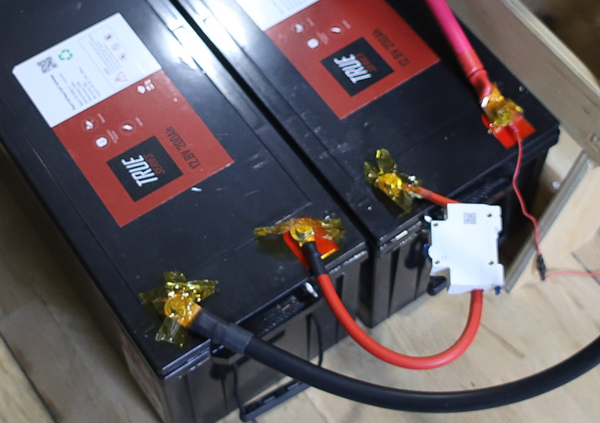Initial Ideas & SetupFor the teardrop camper build I first went with a 12 volt structure simply because that was a good place to start. I did not initially know how many batteries I would be using for this application, and you need at least two 12 volt batteries placed in series to get to 24 volts. It's not that you can do anything more or less with 12 volts over 24 volts, it's just a different way to accomplish the same thing in the end. For a quick refresher. Example 1: You have two 6 volt batteries with a capacity of 10 Amp Hours - So in this case you can have either 6 volts @ 20 Amp Hours or 12 volts @ 10 Amp Hours.
Exampe 2: You have one 12 volt battery with a capacity of 10 Amp Hours - In this case you don't have any choice so it would be 12 volts @ 10 Amp Hours, you can't get to 6 volts, or 24 volts with just the one battery.
Exampe 3: We have two 12 volts 200 Amp Hour Batteries - This happens to be our exact case and you can either have it set up to be 12 volts @ 400 Amp Hours or 24 volts @ 200 Amp Hours.
In the above cases when you add the Amps it is called Parallel. In example 3 you can see that the Amp Hours are doubled to 400, but the volts remain 12. If you want a to double the voltage you have a series, as in the photo below. Series Setup
To do a series like the above photo you have one of the positives connect to the negative of the other battery. Make sure you do not connect the positive to the negative of the same battery, this would cause a short and this would be bad. See Series Circuits on Wikipedia for more information. Parallel Setup
In the above photo the batteries are wired in a parallel way, which mean the voltage stays at 12 and the Amp Capacity is doubled to 400. Here the black connection is connected from one battery to another and the red connection is connected from one battery to another, they never touch at all. Notice that the long heavy cables are from only one battery in both situations. Notice also that there are breakers/fuses placed between the connections. See Parallel Circuits from Wikipedia for more information. DC Connection Setup In my situation, I first went over the DC (direct current) things I wanted to power. (All these items will go through the DC fuse block) As you can see you are dealing with a number of voltages to begin with, 5, 12, & 24 volts, so no matter what your setup is you will need to have a DC Voltage Regulator Buck Converter, or modulate the voltage some other way. Only in a select few situations can you just go right ahead and directly connect the device to the batteries, and even then you will want a fuse anyway. AC Power: 2000 Watt 24 Volt Inverter/ChargerI ended up using a Victron Multiplus for the inverter and charger. This is an item which you must specify to be 12 or 24 volt ahead of time, you can't change this once you buy it. So I selected a 24 volt version after I sent back the 12 volt renogy models that I had some trouble with. One great reason to go with 24 volts is that for any given power situation you are drawing half the amps. Here are a few examples. Example 1: 12 volts from the battery to a 2000 Watt Inverter - 2000 Watts / 12.8 Nominal Volts = ~ 156 Amps
- For a given run length, and depending on the target or acceptable temperature you may need somewhere between 1/0 to 4/0 AWG sizes. This costs somewhere between $45 - $75 for a five foot pair of cables.
Example 2: 24 volts from the battery to a 2000 Watt Inverter - 2000 Watts / 25.6 Nominal Volts = ~ 78 Amps
- In this situation you can go with something like 2 to 4 AWG in a similar situation. This is also a bit cheaper at $20 - $30 for a five foot pair of cables.
Note: American Wire Gauge AWG Wikipedia Everything is a bit easier to work with and is also cheaper. Another Main Reason is to Minimize Voltage DropOver any given cable length there is a voltage drop. It is unavoidable mostly, but you can minimize it with both larger cables, and/or shorter run length. If you need smaller cables it is cheaper to use larger than necessary cables to help minimize the problem, and run cooler. This pretty much sums up what I ended up going with and why. Of course it requires at least two batteries to do this, and you could also investigate 36 or 48 volts if you wanted to. That would allow even lighter and cheaper wires to accomplish the same thing.
|